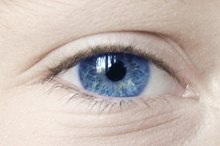Causes of Green Mucus in the Eye
Discharge from the eye can be caused by several conditions. Many people will wake to find a mild accumulation of debris in the nasal regions of their eyelids. In most instances this is simply due to a collection of tear components that gather during sleep. More concern should arise when new or excessive amounts of mucus is present. Mucus discharge that occurs along with changes in vision or eye pain requires evaluation to determine the underlying cause.
If you are experiencing serious medical symptoms, seek emergency treatment immediately.
Eye Infection
Excessive amounts of green mucus in the eye can indicate an ocular infection. Bacterial eye infections often present with a thick, green discharge, along with redness and eye pain. Bacterial eye infections require timely treatment with antibiotics to prevent permanent visual problems. Antibiotics are not necessary for all eye infections, and bacterial resistance can occur with overuse. Eye infections caused by viruses do not respond to antibiotics and therefore eye doctors may utilize other treatment methods. Most people fear the dreaded "pink eye" diagnosis, but often this term simply means that the infection is contagious and in many cases it will resolve without treatment like a common cold. However, all eye infections should be evaluated by an eye doctor to determine the correct diagnosis and treatment.
- Excessive amounts of green mucus in the eye can indicate an ocular infection.
Ocular Allergies
What Causes Eye Mucus?
Learn More
Allergies may be the instigating factor for eye mucus or discharge. Allergic reactions can occur as a result of exposure to animals or seasonal allergens. Medications can cause these reactions, and some individuals are sensitive to particular chemicals and other materials. Ocular allergy sufferers often report a stringy type of discharge that is usually clear or white in color. Itching is the most common symptom associated with allergies. Never rub to relieve allergy itching because this will worsen the condition. Swelling of the eyelids and conjunctiva can be present during an allergic reaction. Prescription allergy eye drops are very effective in alleviating these signs and symptoms. Over the counter allergy eye drops are available, and preservative-free artificial tears can also help. Try closing the eye and applying a cold compress to the eyelids as well.
- Allergies may be the instigating factor for eye mucus or discharge.
- Ocular allergy sufferers often report a stringy type of discharge that is usually clear or white in color.
Dry Eye Syndrome
The American Optometric Association defines dry eye as a condition in which there are insufficient tears to lubricate and nourish the eye 1. Tear film abnormalities associated with dry eye can result in symptoms of discharge, debris along the eyelids, and watering from the eye. Common complaints with dry eye syndrome are eyes that feel scratchy, gritty or sandy. Several over the counter eye lubricants are available for use to enhance the natural tears and minimize these symptoms. Environmental factors such as wind and dust can aggravate this condition, along with prolonged visual use of computers and electronic devices. The use of wrap-around sunglasses, humidifiers and redirecting fans and vents away from the eyes will diminish these environmental effects.
- The American Optometric Association defines dry eye as a condition in which there are insufficient tears to lubricate and nourish the eye 1.
- The use of wrap-around sunglasses, humidifiers and redirecting fans and vents away from the eyes will diminish these environmental effects.
Related Articles
Writer Bio
Dr. Fox completed his Bachelor of Biological Sciences at Ohio University in 2000, and earned both his Master of Science and Doctorate of Optometry at The Ohio State University in 2004. He actively participates as a clinical trials investigator and he has presented his individual research at the Association for Research in Vision and Ophthalmology (ARVO). He has been a consultant for organizations such as Adena Health System and Inventiv Health. Dr. Fox currently is in private practice as a primary care optometrist in central Ohio, although he spent three years practicing and traveling extensively throughout Alaska. Dr. Fox has been a freelance writer for over ten years, and his work has been published by several media outlets including eHow, LIVESTRONG.COM, and The Times Gazette. More information and publications can be viewed at www.foxfreelancewriting.com.









